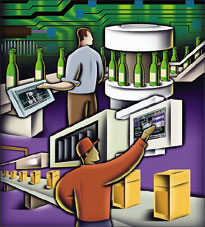EPCglobal, the RFID standards body, is a beehive of activity, working on everything from software standards to performance testing. But lately one area stands out as particularly noteworthy: item-level tagging. Last year, a group was elected to figure out what user needs are for RFID tags that go on items. This year, EPCglobal is asking technology companies to demonstrate ways to meet these needs.
Why does this stand out? One reason is that the move to item-level tagging is what will take the RFID market right into the mainstream. But another, more interesting answer is one not everybody will admit to: The work on item-level tagging is the beginning of EPC Generation 3.
|
|
The idea of new generations of Electronic Product Code tag standards dates back to the summer of 2002. The Auto-ID Center was wrapping up its work on the first set of EPC standards at a meeting in Newport, R.I. In the corner of the room was a flip chart covered with two types of ideas: new and emerging user needs, and new and potentially better ways of meeting them. There was no time to explore these ideas and still have EPC technology on time, so they couldn’t be added to the first standard. But we didn’t want to just throw them away. And so, at the precise moment Generation 1 was finalized, work on Generation 2 began, with the expectation that Generation 2 technology would be commercially available in 2005.
The response to this development was interesting. Vendors with a big stake in Generation 1 protested mildly, disbelieved or were just plain skeptical. Their investment of time, money and emotion in Generation 1 made it hard for them to believe that anything better could ever be invented. But others jumped in, seeing an opportunity to build on the lessons of Generation 1 and stake a place in the EPC market.
And so it will be with Generation 3. The needs of item-level tagging cannot be met with Generation 2, which was designed with pallets and cases in mind. Item-level tags, for example, have security needs that Generation 2 simply cannot meet. Under certain circumstances, Generation 2 tags transmit their identities in a way that anybody listening can hear and understand. That’s fine for pallets and cases in a distribution center, but it’s far from OK for a bottle of Viagra.
The transition from Generation 1 to Generation 2 has proved lots of good things: that EPCglobal can make really great standards; that standing on the shoulders of previous EPC generations is a wonderful way to make things better; and that the RFID market can absorb and embrace dynamic change.
It’s inevitable that RFID will keep improving. And the EPC system has been well designed to take advantage of this via constant regeneration. Come the end of 2008, today’s work on item-level tagging will have yielded Generation 3. And somebody, somewhere, will be thinking about using EPC in ways we can barely imagine today—and an even better standard, Generation 4.
Kevin Ashton was cofounder and executive director of the Auto-ID Center. He is the author of a soon-to-be published book about RFID. Illustration by Jeff Koegel.



